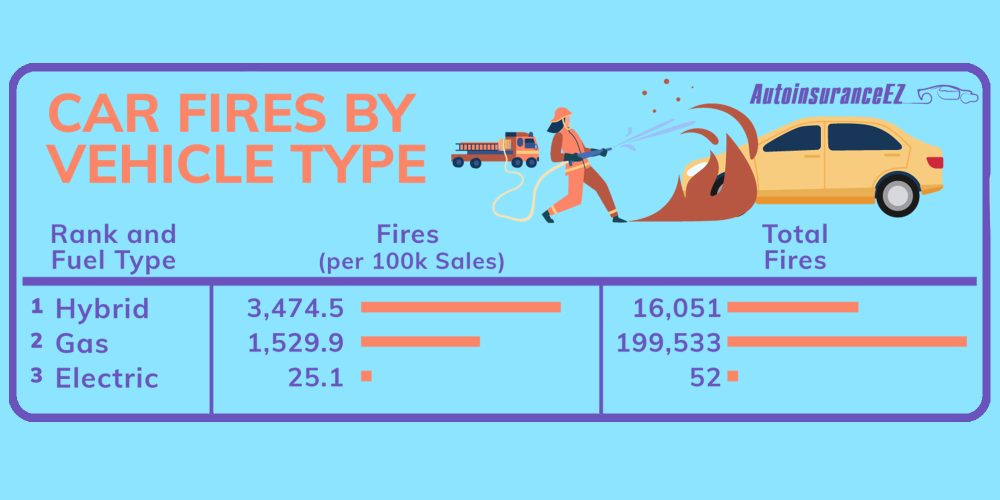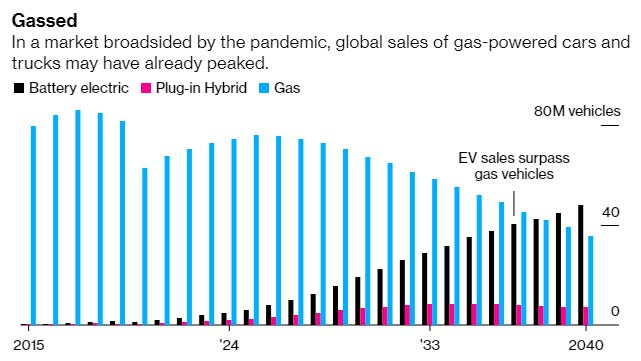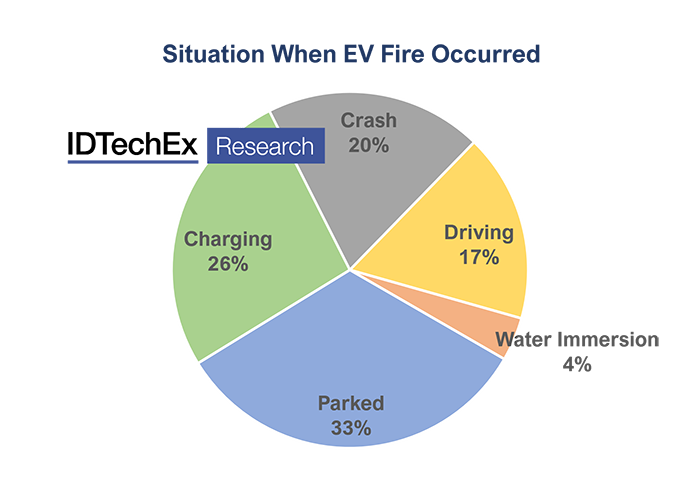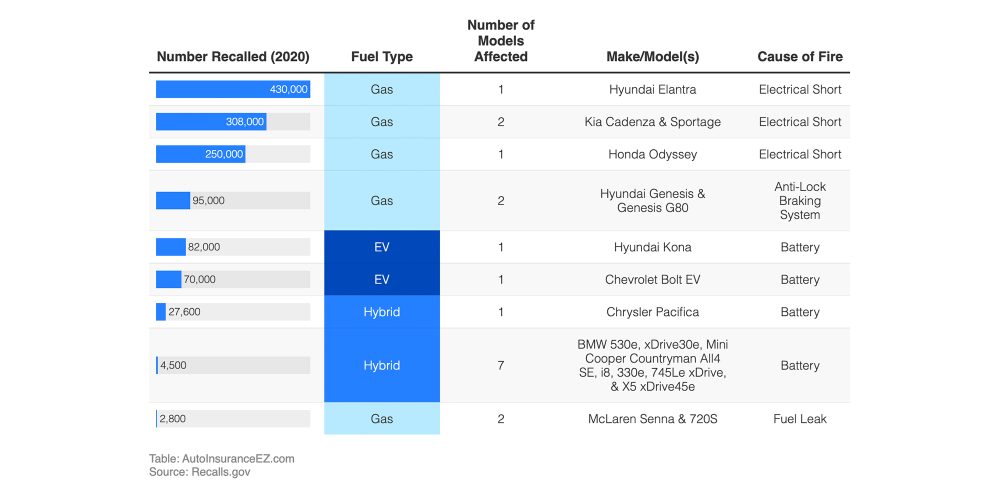Electric vehicles (EVs) have been gaining traction as a more sustainable and eco-friendly mode of transportation. One of the key advantages of EVs is their lower chances of catching fire compared to gasoline-powered vehicles. According to government data, gasoline vehicles are up to 100 times more prone to vehicle fires than their electric counterparts.
Electric Vehicle (EV) Fires Less Likely Than Internal Combustion Engine (ICE) Vehicles
Government data on vehicle fires show that electric cars are less prone to catching fire than internal combustion engine vehicles due to their design and battery technology. Electric vehicles have a lower risk of fire because they do not require combustible fuel storage, have a sealed battery pack that is less susceptible to puncture or leakage, and have a thermal management system to maintain stable battery temperature under normal and extreme operating conditions.

The data also show that EV fires are rare. In the United States, there are only about 2-3 EV fires per billion miles driven, while gasoline-powered vehicles have a rate of about 10-20 fires per billion miles driven. In addition, many EV fires are caused by high-speed collisions and are not inherent to the vehicle or battery technology.
Tesla Supplier CATL Ready to Produce Million-Mile+ Battery
Tesla remains one of the leading EV manufacturers, with a strong focus on battery technology and innovations. One of their suppliers, Contemporary Amperex Technology Co. Ltd. (CATL), has announced that they are ready to produce a million-mile+ battery, which would further push the limits of EVs and their capabilities.

The million-mile battery is designed to outlast the life of the vehicle, with a lifespan of up to 16 years. This battery technology would be a significant step forward in terms of sustainability, as it would reduce the need for battery replacement and limit waste. Additionally, Tesla has been working on new technologies such as solid-state batteries, which have even higher energy density and are less prone to overheating or catching fire.
EV vs. ICE Cost Breakdown and its Effects on EV Adoption
While EVs have many advantages over gasoline vehicles in terms of sustainability and performance, they have historically been more expensive, which has hindered their adoption. However, as battery production becomes more efficient and economies of scale kick in, the cost of EVs is gradually decreasing.

The cost of EVs is largely determined by battery production and EV-specific components. However, long-term savings on fuel and maintenance costs can make EVs more cost-effective over their lifetime compared to gasoline-powered vehicles. Additionally, incentives and rebates can make EVs more affordable for consumers and encourage their adoption.
Environmental Impact of Electric Car Batteries (Production, Use, and Disposal)
While EVs have several sustainability advantages over their gasoline counterparts, they also have environmental impacts associated with the production, use, and disposal of their batteries.

The production of EV batteries requires significant amounts of energy and resources, contributing to carbon emissions and material depletion. However, the overall environmental impact of EV batteries depends on the specific battery chemistry, production method, and energy sources used. Additionally, the use phase of EVs has far lower emissions than gasoline-powered vehicles, and proper disposal and recycling of EV batteries can limit their environmental impact.
EV Fires: A Disaster for Automakers, but an Opportunity for Material Innovations
Although EVs have a lower risk of catching fire than gasoline-powered vehicles, EV fires can be catastrophic for automakers, leading to costly recalls and damage to their brand reputation. To mitigate this risk, automakers and battery manufacturers are investing in new materials and designs to prevent fires and increase battery safety.

New materials such as solid-state electrolytes, nanomaterial coatings, and fire retardants can increase the thermal stability of EV batteries and reduce their risk of catching fire. In addition, designs such as battery modules and pack separation can isolate and contain a potential fire to limit damage. These material and design innovations not only increase EV safety but also have the potential to benefit other industries such as aerospace and energy storage.
Electric vs. Internal Combustion Engine (ICE) Vehicles
Overall, EVs have several advantages over their gasoline-powered counterparts, including lower emissions, lower maintenance costs, and higher performance. While EVs may have a higher initial cost, long-term savings and incentives can make them more cost-effective and accessible for consumers. As battery technology continues to improve and become more sustainable, the future of transportation looks increasingly electric.
Ultimately, the choice between an EV and a gasoline-powered vehicle depends on a variety of factors, including personal preference, lifestyle, and budget. However, the environmental and performance advantages of EVs cannot be ignored, and as more consumers and businesses switch to EVs, the demand for sustainable transportation will continue to grow.
If you are searching about Government data show gasoline vehicles are up to 100x more prone to you've visit to the right place. We have 8 Pics about Government data show gasoline vehicles are up to 100x more prone to like EV vs. ICE Cost Breakdown and its Effects on EV Adoption - Munro, Electric vs. Internal Combustion Engine (ICE) Vehicles | zevrev.org and also Electric vs. Internal Combustion Engine (ICE) Vehicles | zevrev.org. Here you go:
Government Data Show Gasoline Vehicles Are Up To 100x More Prone To
 electrek.co
electrek.co EV Vs. ICE Cost Breakdown And Its Effects On EV Adoption - Munro
 leandesign.com
leandesign.com Electric Vs. Internal Combustion Engine (ICE) Vehicles | Zevrev.org
vs ice electric combustion zev ev internal vehicles engine urging innovation economic ministers mandate transport send letter development science
EV Fires Less Likely Than ICE Vehicles - CRA
 crasa.org.za
crasa.org.za EV Fires: A Disaster For Automakers, But An Opportunity For Material
 www.electronicspecifier.com
www.electronicspecifier.com fires automakers disaster
Environmental Impact Of Electric Car Batteries (Production, Use
 get-green-now.com
get-green-now.com gasoline cycle disposal emissions
Tesla Supplier CATL Is Ready To Produce Million-mile+ Battery - Tesla
 www.teslaoracle.com
www.teslaoracle.com vs ice ev sales graph tesla mile catl million battery 2040 produce supplier ready bloombergnef source
Government Data Show Gasoline Vehicles Are Up To 100x More Prone To
 www.onlineev.com
www.onlineev.com Fires automakers disaster. Gasoline cycle disposal emissions. Government data show gasoline vehicles are up to 100x more prone to

0 Comments